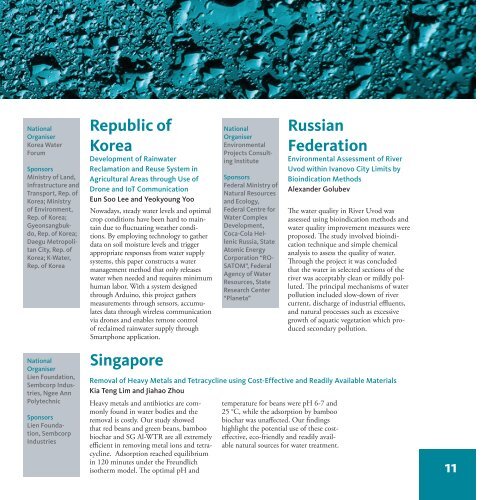2017 Stockholm Junior Water Prize Finalists
Each year, the Stockholm Junior Water Prize congregates young scientists and innovators from around the world who have created new solutions to the planet’s growing water challenges. Each of the finalists represented in Stockholm are the champions of their national competition and have been selected as winners from thousands of entries for their outstanding work.
Each year, the Stockholm Junior Water Prize congregates young scientists and innovators from around the world who have created new
solutions to the planet’s growing water challenges. Each of the finalists represented in Stockholm are the champions of their national
competition and have been selected as winners from thousands of entries for their outstanding work.
Create successful ePaper yourself
Turn your PDF publications into a flip-book with our unique Google optimized e-Paper software.
National<br />
Organiser<br />
Korea <strong>Water</strong><br />
Forum<br />
Sponsors<br />
Ministry of Land,<br />
Infrastructure and<br />
Transport, Rep. of<br />
Korea; Ministry<br />
of Environment,<br />
Rep. of Korea;<br />
Gyeonsangbukdo,<br />
Rep. of Korea;<br />
Daegu Metropolitan<br />
City, Rep. of<br />
Korea; K-<strong>Water</strong>,<br />
Rep. of Korea<br />
National<br />
Organiser<br />
Lien Foundation,<br />
Sembcorp Industries,<br />
Ngee Ann<br />
Polytechnic<br />
Sponsors<br />
Lien Foundation,<br />
Sembcorp<br />
Industries<br />
Republic of<br />
Korea<br />
Development of Rainwater<br />
Reclamation and Reuse System in<br />
Agricultural Areas through Use of<br />
Drone and IoT Communication<br />
Eun Soo Lee and Yeokyoung Yoo<br />
Nowadays, steady water levels and optimal<br />
crop conditions have been hard to maintain<br />
due to fluctuating weather conditions.<br />
By employing technology to gather<br />
data on soil moisture levels and trigger<br />
appropriate responses from water supply<br />
systems, this paper constructs a water<br />
management method that only releases<br />
water when needed and requires minimum<br />
human labor. With a system designed<br />
through Arduino, this project gathers<br />
measurements through sensors, accumulates<br />
data through wireless communication<br />
via drones and enables remote control<br />
of reclaimed rainwater supply through<br />
Smartphone application.<br />
Singapore<br />
Removal of Heavy Metals and Tetracycline using Cost-Effective and Readily Available Materials<br />
Kia Teng Lim and Jiahao Zhou<br />
Heavy metals and antibiotics are commonly<br />
found in water bodies and the<br />
removal is costly. Our study showed<br />
that red beans and green beans, bamboo<br />
biochar and SG Al-WTR are all extremely<br />
efficient in removing metal ions and tetracycline.<br />
Adsorption reached equilibrium<br />
in 120 minutes under the Freundlich<br />
isotherm model. The optimal pH and<br />
National<br />
Organiser<br />
Environmental<br />
Projects Consulting<br />
Institute<br />
Sponsors<br />
Federal Ministry of<br />
Natural Resources<br />
and Ecology,<br />
Federal Centre for<br />
<strong>Water</strong> Complex<br />
Development,<br />
Coca-Cola Hellenic<br />
Russia, State<br />
Atomic Energy<br />
Corporation “RO-<br />
SATOM”, Federal<br />
Agency of <strong>Water</strong><br />
Resources, State<br />
Research Center<br />
“Planeta”<br />
Russian<br />
Federation<br />
temperature for beans were pH 6-7 and<br />
25 °C, while the adsorption by bamboo<br />
biochar was unaffected. Our findings<br />
highlight the potential use of these costeffective,<br />
eco-friendly and readily available<br />
natural sources for water treatment.<br />
Environmental Assessment of River<br />
Uvod within Ivanovo City Limits by<br />
Bioindication Methods<br />
Alexander Golubev<br />
The water quality in River Uvod was<br />
assessed using bioindication methods and<br />
water quality improvement measures were<br />
proposed. The study involved bioindication<br />
technique and simple chemical<br />
analysis to assess the quality of water.<br />
Through the project it was concluded<br />
that the water in selected sections of the<br />
river was acceptably clean or mildly polluted.<br />
The principal mechanisms of water<br />
pollution included slow-down of river<br />
current, discharge of industrial effluents,<br />
and natural processes such as excessive<br />
growth of aquatic vegetation which produced<br />
secondary pollution.<br />
11


















